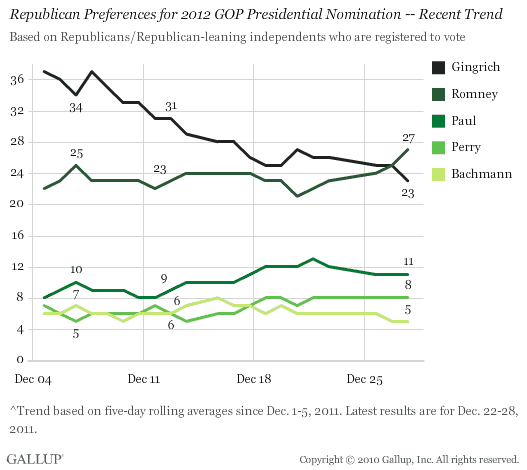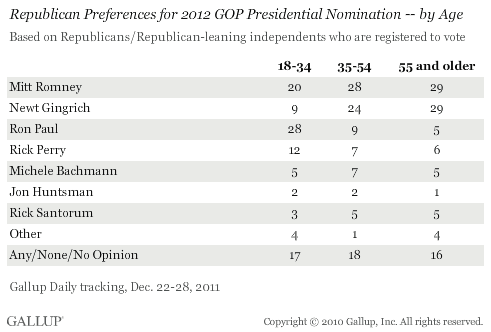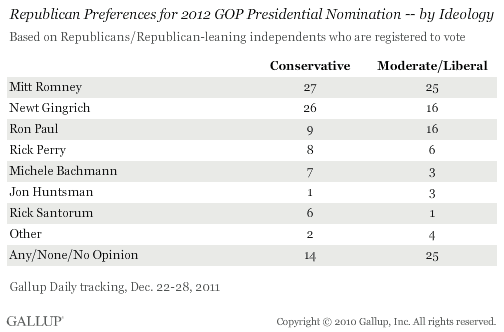PRINCETON, NJ -- Mitt Romney has edged ahead of Newt Gingrich, 27% to 23%, for the national lead among Republican voters for the first time since Gallup Daily tracking of the Republican race began on Dec. 1. Ron Paul remains in deep third place with 11% of the GOP vote, followed by Rick Perry at 8%.

Former Speaker of the House Gingrich began December with a dominant lead over the rest of the field with 37% support, compared with Romney's 22% and single-digit percentages for all other candidates. Gingrich's support began to fall after the first week of December, landing at his current 23% for the five days of interviewing conducted Dec. 22-23 and Dec. 26-28.
The collapse in Gingrich's lead has been accompanied by slight gains for other candidates, as well as a small increase in the percentage of Republicans who don't have a specific choice for their party's nomination.
Support for Romney, who now has a 4-point lead over Gingrich, has risen to 27% from 22% in Gallup's first tracking report in early December. Although not a major surge, this represents the highest level of support for Romney since tracking began on Dec. 1 and ties his record-high level of support among all Republicans measured in June. Romney has generally been among the front-runners even as other candidates have risen and fallen around him, and he was the clear leader earlier in the year.
Paul's support is up three percentage points since early December, while Perry, Michele Bachmann, Rick Santorum, and Jon Huntsman are all in roughly the same positions now as they were then. The percentage of Republicans who don't have a choice for their party's nomination has edged up from 14% in early December to 16%, but has been as high as 20% at times earlier in the year.
Young Republican Voters Support Paul, Older Voters Back Gingrich and Romney
Republicans' support for the candidates varies dramatically by age, as has generally been the case in recent months. Gingrich's support rises from 9% among 18- to 34-year-old Republicans to 24% among those aged 35 to 54, with 29% support among those 55 and older. Paul's support follows the opposite pattern. He leads all other candidates among Republicans aged 18 to 34 with 28% support, but has only single-digit support among those 35 and older. Romney's support is at 20% among younger Republicans, rising to 28% and 29% among those in the two older age categories.

Overall, Paul is the first choice for Republicans aged 18 to 34. Romney wins among Republicans aged 35 to 54, and Gingrich and Romney are tied among those 55 and older.
Moderate/Liberal Republicans Support Romney
Seven in 10 Republican voters in the latest sample are conservatives, and among this group Romney and Gingrich are essentially tied, with 27% and 26% support, respectively. Among the 30% of Republicans who identify themselves as moderate or liberal, Romney wins with 25% support, followed by Gingrich and Paul at 16% each.

Implications
The race for the Republican nomination has been characterized this year by substantial ebbs and flows in support for the various contenders. Perry, Herman Cain, and Gingrich all enjoyed brief rises in support levels, only to fall back within weeks coincident with the high level of focus and attacks from fellow candidates that accompany front-runner status. Support for Romney, on the other hand, has been much steadier, and for the first time in months he is back in the lead, albeit by a narrow margin of four points.
All of this movement in the polling data has taken place as part of the "invisible primary" this year -- driven by a heavy schedule of nationally televised debates, media coverage, and millions of dollars spent on television advertising both in key early-voting states and on national cable television.
On Tuesday, the first actual voting of the election season begins with the Iowa caucuses, followed by the New Hampshire primary on Jan. 10. The historical record shows that these results have the potential to significantly change the preferences of Republicans nationally, in essence shaking up the race.
The key issue at this point is the impact of the early voting on Romney's front-runner status. If Romney wins or is perceived to have done well in Iowa, and then -- as expected -- does well in New Hampshire, he may be on his way to cementing the early momentum for a sweep to the nomination. If, on the other hand, he is perceived to have stumbled in Iowa, and does not meet expectations in New Hampshire, the race may continue to be an open one for weeks or months to come.
Survey Methods
Results are based on telephone interviews conducted as part of Gallup Daily tracking Dec. 22-28, 2011, with a random sample of 1,169 Republicans registered to vote, aged 18 and older, living in all 50 U.S. states and the District of Columbia.
For results based on the total sample of Republican registered voters, one can say with 95% confidence that the maximum margin of sampling error is ±4 percentage points.
Interviews are conducted with respondents on landline telephones and cellular phones, with interviews conducted in Spanish for respondents who are primarily Spanish-speaking. Each sample includes a minimum quota of 400 cell phone respondents and 600 landline respondents per 1,000 national adults, with additional minimum quotas among landline respondents by region. Landline telephone numbers are chosen at random among listed telephone numbers. Cell phone numbers are selected using random-digit-dial methods. Landline respondents are chosen at random within each household on the basis of which member had the most recent birthday.
Samples are weighted by gender, age, race, Hispanic ethnicity, education, region, adults in the household, and phone status (cell phone only/landline only/both, cell phone mostly, and having an unlisted landline number). Demographic weighting targets are based on the March 2010 Current Population Survey figures for the aged 18 and older non-institutionalized population living in U.S. telephone households. All reported margins of sampling error include the computed design effects for weighting and sample design.
In addition to sampling error, question wording and practical difficulties in conducting surveys can introduce error or bias into the findings of public opinion polls.
For more details on Gallup's polling methodology, visit https://www.gallup.com/.
